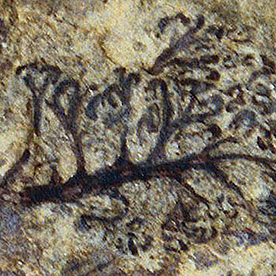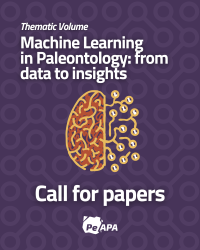CAMPO CHICO FORMATION, AN AMAZING WINDOW TO THE FLORA AND FAUNA FOSSIL FROM DEVONIAN TIMES (GIVETIAN– FRASNIAN), PERIJá RANGE, VENEZUELA
DOI:
https://doi.org/10.5710/PEAPA.08.03.2022.401Keywords:
Devonian, Perijá, Campo Chico Formation, Fossil fishes, Fossil plants, Paleogeography, GondwanaAbstract
In this study, we present a review of the stratigraphy and paleontological remains discovered during the last years in the Campo Chico Formation (Devonian), Sierra de Perijá, Venezuela. The Campo Chico Formation is composed of grey/white, sandstones and conglomerates, interbedded with mudstones and some thin localized coals. The formation is interpreted as a marginal continental cycle with some marine influence towards the top. The thickness of the Campo Chico Formation is about 450 meters. Campo Chico Formation was dated based upon miospore assemblages as middle Givetian–middle Frasnian. The fossil fauna has provided the first Devonian record for Venezuela, of three major fish groups: antiarch, placoderms, and dipnoans, with endemic elements of Gondwana affinities. The floral fossil, dominated by lycophytes, is the most diverse of mid–late Devonian age from Gondwana, and closely resemble the eastern North America (Euramerica). Plotting the Sierra de Perijá and New York floral occurrences onto the more recent palaeocontinental reconstructions for the Late Devonian, shows that the two localities were located in a warm temperate belt, between Gondwana and Euramerica. A narrow marine barrier separating the two continents is postulated for Campo Chico time.
References
Benedetto, J. L. (1980). Síntesis bioestratigráfica del Paleozoico tardío en la Sierra de Perijá, Venezuela. Anais da Academia Brasileira de Ciencias, 52, 827–839.
Benedetto, J. L. (1984). Les Brachiopodes Devoniens de la Sierra de Perijá (Venezuela): systematiques et implications paleographiques. Biostratigraphie du Paleozoique. Universite de Bretagne Occidentale. http://pi.lib.uchicago.edu/1001/cat/bib/890187
Berry, C. M. (1993). Devonian plant assemblage from Venezuela. [Tesis Doctoral, University of Wales, United Kingdom]. Berry, C. M., Casas, J. E. y Moody, J. M. (1992). Diverse Devonian Plant assemblages from Venezuela. Documents des Laboratoire de Géologie de Lyon, 125, 29–42. https://www.persee.fr/doc/geoly_0750-6635_1993_act_125_1_1546
Berry, C. M., Casas, J. E., Moody, J. M. y Young, G. (1997). Síntesis estratigráfica y paleontológica de la Formación Campo Chico (Devónico Medio–Superior), Sierra de Perijá. Memorias del 8º Congreso Geológico Venezolano, Sociedad Venezolana de Geólogos (vol. 1, pp. 125–132). Porlamar, Venezuela.
Berry, C. M. y Edwards, D. (1997). A new species of the lycopsid Gilboaphyton Arnold from the Devonian of Venezuela and New York State, with a revision of the closely related genus Archaeosigillaria Kidston. Review of Palaeobotany and Palynology, 96(1), 47–70. https://doi:10.1016/S0034-6667(96)00015-2
Berry, C. M. y Gensel, P. (2019). Late Mid Devonian Sawdonia (Zosterophyllopsida) from Venezuela. International Journal of Plant Sciences, 180(6), 540–557. https://doi.org/10.1086/702940
Blakey, R. C. (2008). Gondwana paleogeography from assembly to breakup - A 500 m.y. Odyssey. En C. R. Fielding, T. D. Frank y J. L. Isbell (Eds.), Resolving the Late Paleozoic Ice Age in Time and Space (pp. 1–28). Geological Society of America Special Paper 441. https://doi.org/10.1130/2008.2441(01)
Blakey, R. C. (2020). Deep Time Maps. Recuperado el 15 de octubre de 2021, https://deeptimemaps.com/north-america/
Boucot, A. J. (1985). Late Silurian–Early Devonian biogeography, provincialism, evolution and extinction. Philosophical Transactions of the Royal Society of London, 309(1138), 323–339. https://doi.org/10.1098/rstb.1985.0089
Boucot, A. J., Xu, C. y Scotese, C. (2013). Phanerozoic Paleoclimate: An Atlas of Lithologic Indicators of Climate. SEPM Concepts in Sedimentology and Paleontology, 11, 478 p.
Casas, J. E., Berry, C. M. y Moody, J. (1990). Estudio Paleontológico de la Formación Campo Chico (Devónico medio–superior). Maraven (Filial de Petróleos de Venezuela), Reporte Interno. Informe Técnico #10905. 20 p.
Casas, J. E., Moody, J. M. y Young, G. C. (1992). Vertebrados fósiles de la Formación Campo Chico (Devónico medio–superior). Maraven (Filial de Petróleos de Venezuela), Reporte Interno EPC-12.972, Caracas, 20 p.
Edwards, D. y Benedetto, J. L. (1985). Two new species of herbaceous lycopods from the Devonian of Venezuela with comments on their taphonomy. Palaeontology, 28(3), 599–618.
González de Juana, C., Iturralde, J. M. y Piccard, X. (1980). Geología de Venezuela y de sus Cuencas Petrolíferas (pp. 124–126). Ediciones Foninves, Caracas.
Hammond, S. y Berry, C. M. (2005). A new species of Tetraxylopteris (Aneurophytales) from the Devonian of Venezuela. Botanical Journal of the Linnean Society, 148(3), 275–303. https://doi:10.1111/J.1095-8339.2005.00418.X
Harvey, C. (1999). Middle and Upper Devonian palynology of the Sierra de Perijá, western Venezuela. Palaeontological Association Newsletter (abstracts), 42, 17–18.
Harvey, C. (2001). Palynology and Coal Analysis of the Devonian Campo Chico Formation, Western Venezuela. [Tesis Doctoral, University of Sheffield].
Janvier, P. (2007). The Devonian vertebrates of South America: Malvinokaffric fishes and Gondwana-Euramerica faunal interchange. En E. Díaz-Martínez y I. Rábano (Eds.), 4th European Meeting on the Palaeontology and Stratigraphy of Latin America. Cuadernos del Museo Geominero, Nº 8. Instituto Geológico y Minero de España, Madrid.
Janvier, P. y Villarroel, C. (1998). Los peces Devónicos del Macizo de Floresta (Boyacá, Colombia). Consideraciones taxonómicas, bioestratigráficas, biogeográficas y ambientales. Geología Colombiana, 23, 3–18. https://revistas.unal.edu.co/index.php/geocol/article/view/31461
Janvier, P. y Villarroel, C. (2000). Devonian vertebrates from Colombia. Palaeontology, 43, 729–763. https://doi.org/10.1111/1475-4983.00147
Kellogg, J. (1984). Cenozoic tectonic history of the Sierra de Perijá, Venezuela-Colombia, and adjacent basins. Geological Society of America, 162, 239–261.
Kent, V. y Van Der Voo, R. (1990). Palaeozoic Palaeogeography from paleomagnetism of the Atlantic-bordering continents. En W. McKerrow y C. Scotese (Eds.), Palaeozoic Palaeogeography and Biogeography (pp. 49–56). Geological Society Memoir 12, London.
Li, Z. X. y Powell, C. M. (2001). An outline of the palaeogeographical evolution of the Australasian region since the beginning of the Neoproterozoic. Earth Science Reviews, 53, 237–277.
Liddle, R. A., Harris, G. D. y Wells, J. W. (1943). The Rio Cachirí section in the Sierra de Perijá, Venezuela. Bulletin of American Paleontology, 27(108), 273–368.
Maze, W. (1984). Jurassic La Quinta Formation in the Sierra de Perijá, northwestern Venezuela: Geology and tectonic environ ment of red beds and volcanic rocks. Geological Society of America, 162, 263–282.
Olive, S., Pradel, A., Martínez-Pérez, C., Janvier, P., Lamsdell, J. C., Gueriau, P., Rabet, N., Duranleau-Gagnon, P., Cárdenas-Rozo, A. L., Zapata, P. A. y Botella, H. (2019). New insights into Late Devonian vertebrates and associated fauna from the Cuche Formation (Floresta massif, Colombia). Journal of Vertebrate Paleontology, 39(23), 1–19.
Pastor-Chacón, A., Reyes-Abril, J., Cáceres-Guevara, C., Sarmiento, G. y Cramer, T. (2013). Análisis estratigráfico de la sucesión del Devónico-Pérmico al oriente de Manaure y San José de Oriente (Serranía del Perijá, Colombia). Geología Colombiana, 38, 5–24.
Prestianni, C., Meyer-Berthaud, B., Blanchard, R., Rücklin, M., Clément, G. y Gerrienne, P. (2012). The Middle Devonian plant assemblage from Dechra Aït Abdallah (Central Morocco) revisited. Review of Palaeobotany and Palynology, 179, 44–55. https://doi:10.1016/j.revpalbo.2012.03.011
Restrepo, J. J. y Toussaint, J. F. (2020). Tectonostratigraphic Terranes in Colombia: An Update. First Part: Continental Terranes. En J. Gómez y D. Mateus-Zabala (Eds.), The Geology of Colombia, Volume 1 Proterozoic – Paleozoic (pp. 37–63). Servicio Geológico Colombiano, Publicaciones Geológicas Especiales 35. https://doi.org/10.32685/pub.esp.35.2019.03
Richardson, J. B. y McGregor, D. C. (1986). Silurian and Devonian spore zones of the Old Red Sandstone Continent and adjacent regions. Bulletin of Geological Survey of Canada, 364, 1–79.
Scotese, C. (2003) Paleomap Project. Recuperado el 15 de octubre de 2021, http://www.scotese.com/ldevclim.htm
Scotese, C. y McKerrow, W. (1990). Revised world maps and introduction. En W. McKerrow y C. Scotese (Eds.), Palaeozoic Palaeogeography and Biogeography (pp. 1–21). Geological Society Memoir, 12, London.
Stein, W. Mannolini, F., VanAller, L., Landing, E. y Berry, C. (2007). Giant cladoxylopsid trees resolve the enigma of the Earth’s earliest forest stumps at Gilboa. Nature, 446, 904–907.
Sutton, F. A. (1946). Geology of Maracaibo Basin, Venezuela. American Association of Petroleum Geology, 30(10), 1621–1741.
Tait, J., Schatz, M., Bachtadse, V. y Soffel, H. (2000). Palaeomagnetism and Palaeozoic paleogeography of Gondwana and European terranes. En W. Franke, V. Haak, O. Oncken y D. Tanner (Eds.), Orogenic Processes: Quantification and Modelling in the Variscan Belt (pp. 21–34). Geological Society of London, Special Publication 179, London.
Van der Lelij, R., Spikings, R., Ulianov, A., Chiaradia, M. y Mora, A. (2016). Palaeozoic to Early Jurassic history of the northwestern corner of Gondwana, and implications for the evolution of the Iapetus, Rheic and Pacific Oceans. Gondwana Research, 31, 271–294.
Weisbord, N. (1926). Venezuelan Devonian fossils. Bulletin of American Paleontology, 11(46), 223–268.
Young, G. C. (1982). Devonian sharks from South-eastern Australia and Antarctica. Palaeontology, 25(4), 817–843.
Young, G. C. (1993). Vertebrate Faunal Provinces in the Middle Palaeozoic. En J. Long (Ed.), Palaeozoic Vertebrate Biostratigraphy and Biogeography (pp. 293–323). Belhaven Press, London.
Young, G. C. (2003). North Gondwana mid-Palaeozoic connections with Euramerica and Asia: Devonian vertebrate evidence. Courier Forschungsinstitut Senckenberg, 242, 169–185.
Young, G. C., Burrow, C., Long, J. A., Turner, S. y Choo, B. (2010). Devonian macrovertebrate assemblages and biogeography of East Gondwana (Australasia, Antarctica). Palaeoworld, 19, 55–74. https://doi:10.1016/j.palwor.2009.11.005
Young, G. C. y Moody, J. M. (2002). A Middle-Late Devonian fish fauna from the Sierra de Perijá, western Venezuela, South America. Mitteilung Museum Naturkunde Berlin Geowiss Reihe, 5, 155–206. https://doi.org/10.1002/mmng.20020050111
Young, G. C., Moody, J. M. y Casas, J. E. (2000). New discoveries of Devonian vertebrates from South America, and implications for Gondwana-Euramerica contact. Comptes Rendus de 1’Academie des Sciences, Pans, 331, 755–761.

Additional Files
Published
Issue
Section
License
Copyright (c) 2022 Jhonny Edgar Casas, Christopher Berry, John Mason Moody, Gavin Young

This work is licensed under a Creative Commons Attribution-NoDerivatives 4.0 International License.
Authors retain copyright and grant the journal right of first publication with the work simultaneously licensed under a Atribución/Reconocimiento 4.0 Internacional that allows others to share the work with an acknowledgement of the work's authorship and initial publication in this journal.
















